Helicoids are essential for focusing a manual lens. While it is a joy to focus with one, it is a big pain to repair for beginners and it can really be a show-stopper if you do not know how and where these things should mate when reassembling a lens.
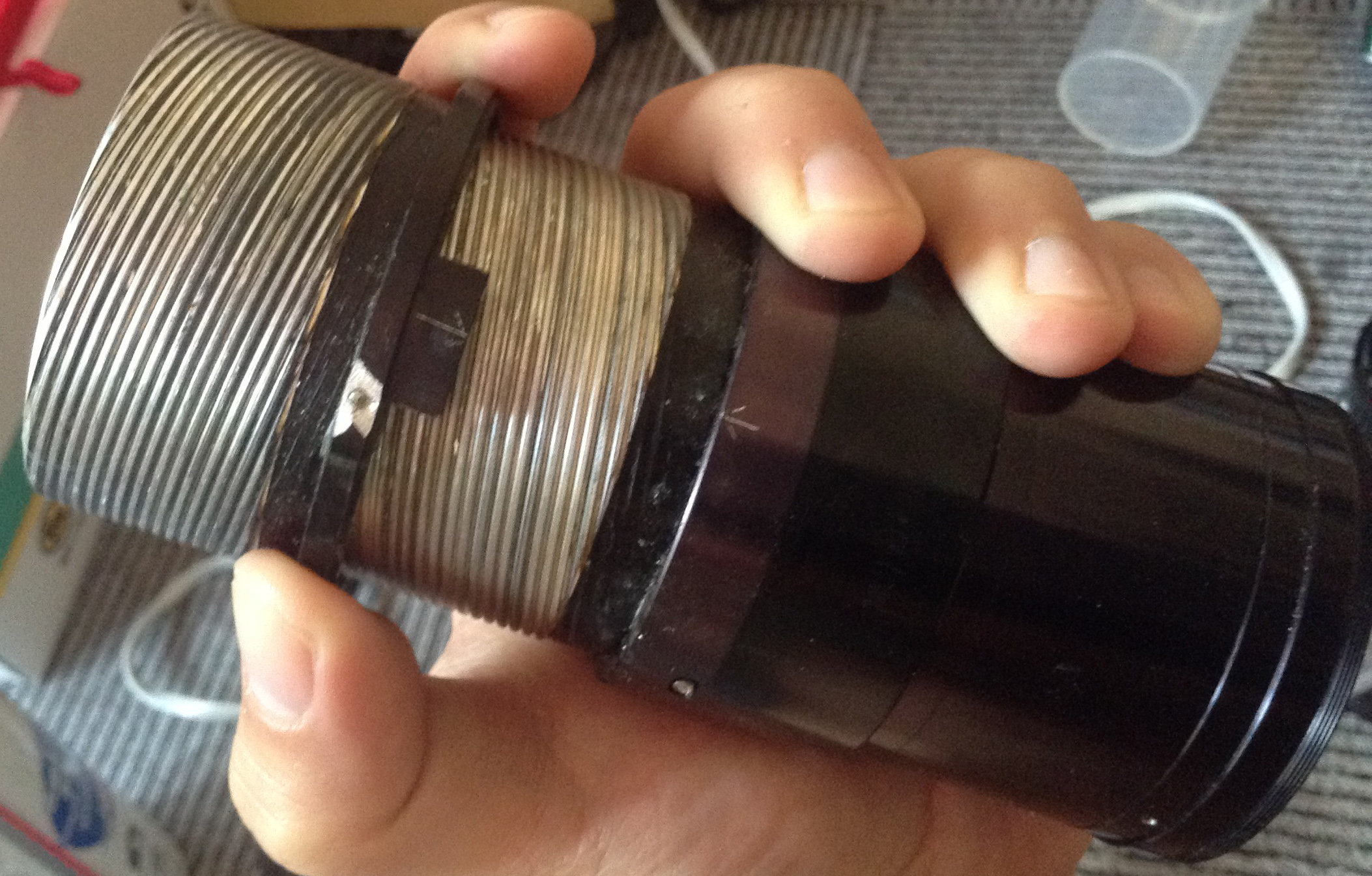
Helicoids are a thing of the past for the AF (autofocus) generation but for connoisseurs like us who enjoy and appreciate older (or current) manual focus lenses, the helicoid is the soul of the lens when it comes to focusing because this is the one thing that affects us the most as we turn the focus ring left and right.The helicoids are also the source of frustration and the root cause for their lens’ problems for many. Lenses that were poorly kept and maintained will exhibit some form of focusing problem ranging from a seized helicoid to dry focusing sensation.
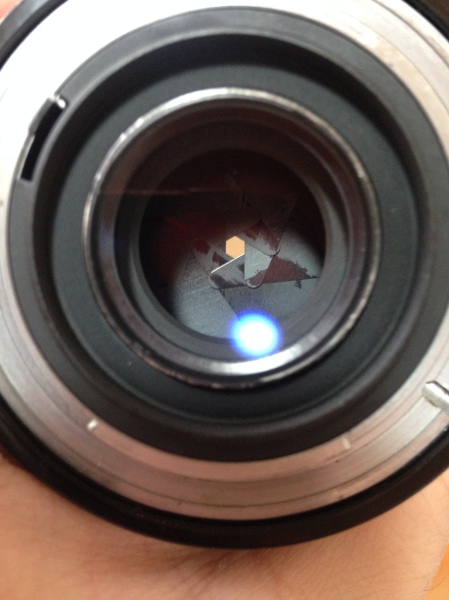
The helicoids or rather the grease used on them can be the source of other problems like oily aperture blades. Using the wrong lubricant or using the right one in excessive amount will leave you with this problem.

Excess grease can also result in disgusting situations like this as well. The focusing on this lens was very well damped but opening the lens showed that the grease has migrated and is now on parts where it should not be in.
The helicoids are also a source of frustration for many inexperienced repairmen when they have failed to document the process properly and this blog post is going to teach you how to prevent this from happening to you as well as refresh the helicoids so that they perform optimally for more decades to come!
Before We Begin:
If this is the first attempt at opening a lens then I suggest that you read my previous posts regarding screws & drivers, grease and other things. Also read regarding the tools that you will need in order to fix your Nikkors.
I highly suggest that you read these primers before you begin (for beginners):
Reading these primers should lessen the chance of ruining your lens if you are a beginner. Also before opening up any lens, always look for other people who have done so in Youtube and the internet. Information is scarce, vague and scattered (that is why I started this) but you can still find some information if you search carefully.
Before You Begin (Tools):
Servicing the helicoids themselves doesn’t require a lot of tools but it pays to use the right one for the task. Most of these can be bought over the counter so you should not have any trouble getting them.
Toothbrushes: You will need at least (2) of these. I just buy the cheap, hard and broad ones.
Kleenex: You will need plenty of these.
Lighter fluid: Just use any generic Zippo lighter oil. A stronger alternative is kerosene but I have a baby at home so this is a big no.
Grease: Use the right type of grease for your helicoids. Please read my grease blog post.
Flat brush: A cheap broad brush for painting is fine. I use these to apply the grease.
Cotton buds: These are useful for accessing those hard-to-reach corners.
Dremel: I would need a Dremel with wire brush occasionally for those caked grime that just won’t go away with simple wiping.
Flat screwdriver: You will need this to scribe marks on the surface of the metal parts.
Denatured alcohol: I use this as bath to soak my helicoids in. Place it inside a container with a cover.
Bulb blower: You should have one at this point. Get a good one with a powerful burst.
Newspaper: Just to make sure that you do not soil or ruin the floor.
As with anything chemical or combustible, always handle these with care and always work in a well ventilated place. I will not be responsible for any result or accidents.
Before You Begin (Taking Notes):
Before you begin dismantling the helicoids, make sure that you took sufficient notes of it. Using your phone’s camera is probably the most convenient way to do it, the workers at my family’s watch repair shop used to write and draw the notes on a notebook.
These marks will also indicate that a lens has been previously serviced if you find existing ones when you open them. They can also be made by the manufacturer themselves during the milling process.
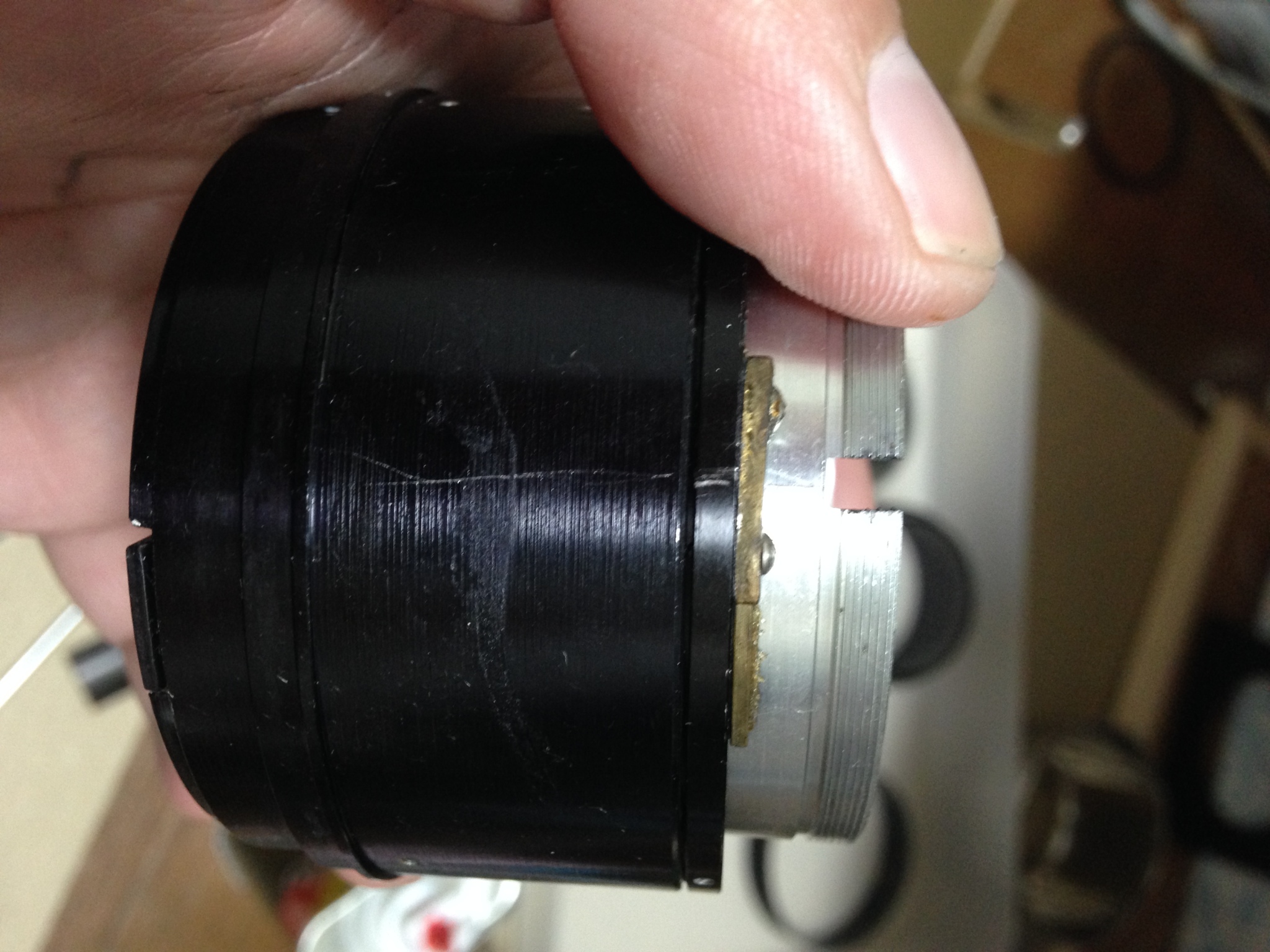
Another way is scribe shallow marks with a sharp tool on the surface. Sometimes, I would turn the helicoids until it is completely compressed and then scribe a thin diagonal mark on the surface of the 2 helicoids so that I will have a visual reference later to see if I have mated the helicoids properly. If the line aligned then I did a good job.
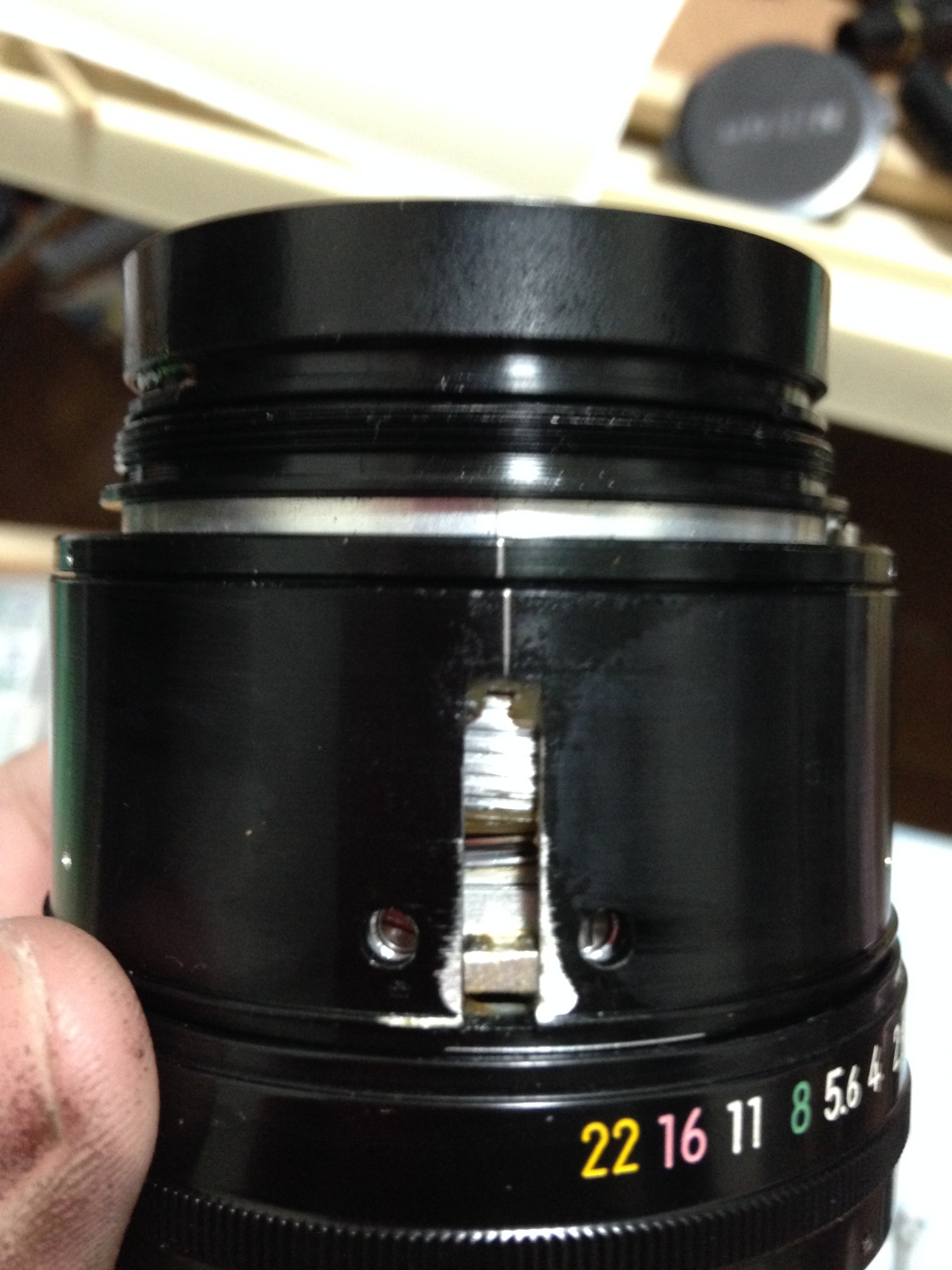
Be sure to mark the centreline (infinity line) of the parts so that you know how they should align when focused to infinity. The line in the picture is a bit off because I have rotated it by a few millimetres.
Not leaving any repair marks on any of the internal parts is a sign of a skilled repairman. While I agree with that statement, I would rather be on the safe side. Since I own most of the stuff that I service it’s OK. I am sure that the people who I have cleaned for won’t mind as well.
Separating and Marking:
This step is the most important part of the overhaul process (for the helicoids) so please read this carefully. Messing up this step will ruin your experience and make your time with this lens miserable.
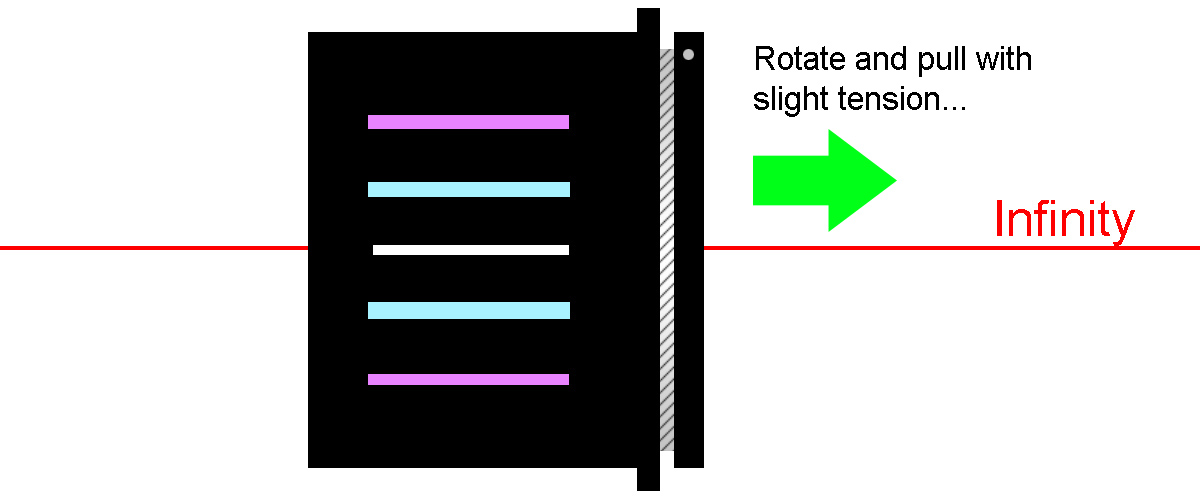
Rotate the helicoid while maintaining a light but even tension. Be careful with it and go slowly, pausing and checking the helicoids as you go so that you know how much more it will take before it separates.
It can be deceiving sometimes as it may seem that you still have a long way to go but the reality is you are only a few degrees away before they separate! Go slowly and gently as if you are a bank robber opening the safe to the national treasury.
Always use the median line of the lens (where the infinity mark line is) as a landmark so that you have a constant point of reference. The infinity line is also convenient because it is easy to remember.
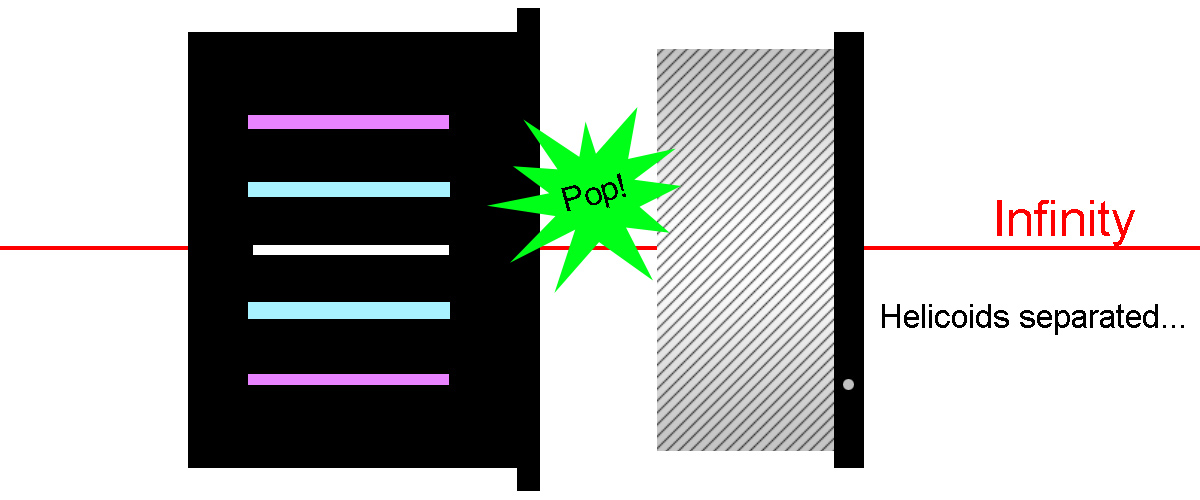
The tension that you are applying is to give you some indication wether the helicoids have separated or not. As the helicoids separate, you will feel a slight pop as an indication that you should stop turning your helicoids.
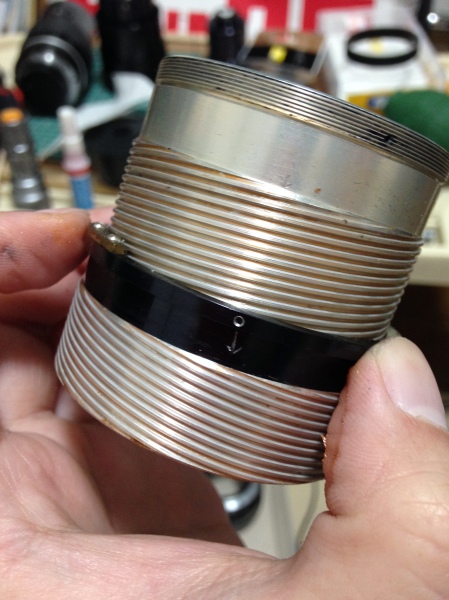
The illustration above is just an exaggeration of what actually happens (to illustrate a point), in reality what you will have is closer this picture. The pop is more like a sensation of the helicoids separating.
Examine and take note where they have separated. This is a very important step so please take your time, missing this or getting this wrong will cost you a lot of time later on when you reassemble your lens!
Remember which part of the helicoid coincides with the infinity line of the main helicoid. There are times when Nikon would give you hints as to where these are. These hints will usually coincide with something else in the lens like the infinity line, a screw hole, a mark or engraved letter in the lens, a groove, etc. Be on the lookout for these!
Common hints are:
- a clean hole that serves no purpose
- a scratch made by Nikon or a repairman
- the helicoid stop
- slots and canals
In the absence of any of the above, sometimes the stain and grime left on the surface of the helicoid are what I use to remind me of the separation position. Anything goes!!!
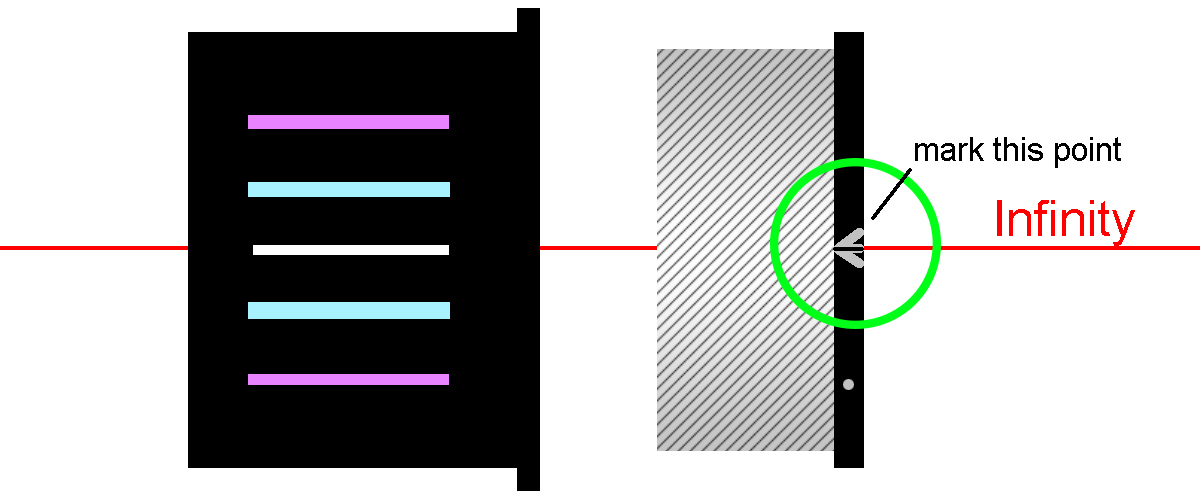
Be sure to mark the position by scratching a fine mark on the surface of the helicoid. Just be sure that the mark is small but clear enough for you to see and understand. Also make sure that the mark is not on the grooves or threads of the helicoid itself or in any moving mechanical part that comes in contact with that surface because it will interfere or make your focusing feel rough.
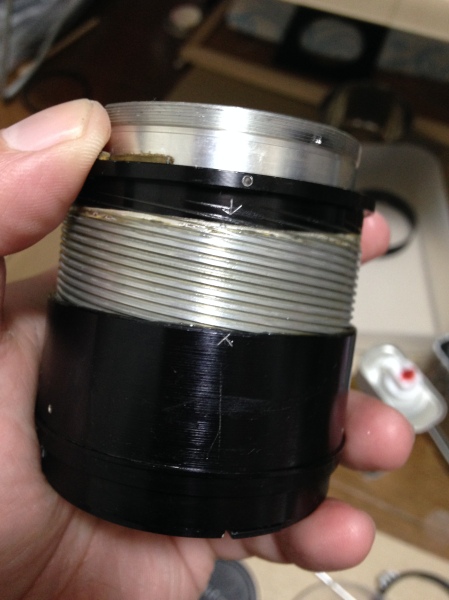
This is a real life example of how it should look like. Notice that the arrows align and mark where the helicoids separated. This is also the position that these should be in when you mate them back together again later.
You can also read this blog post with a video of me working on a set of helicoids. I’ll show you my workflow for guessing where a helicoid’s mating point it. It won’t work if you do not have any reference points or pictures of it before you separate them or pictures of it in it’s infinity position. Having any of those will help you guess where it should be.
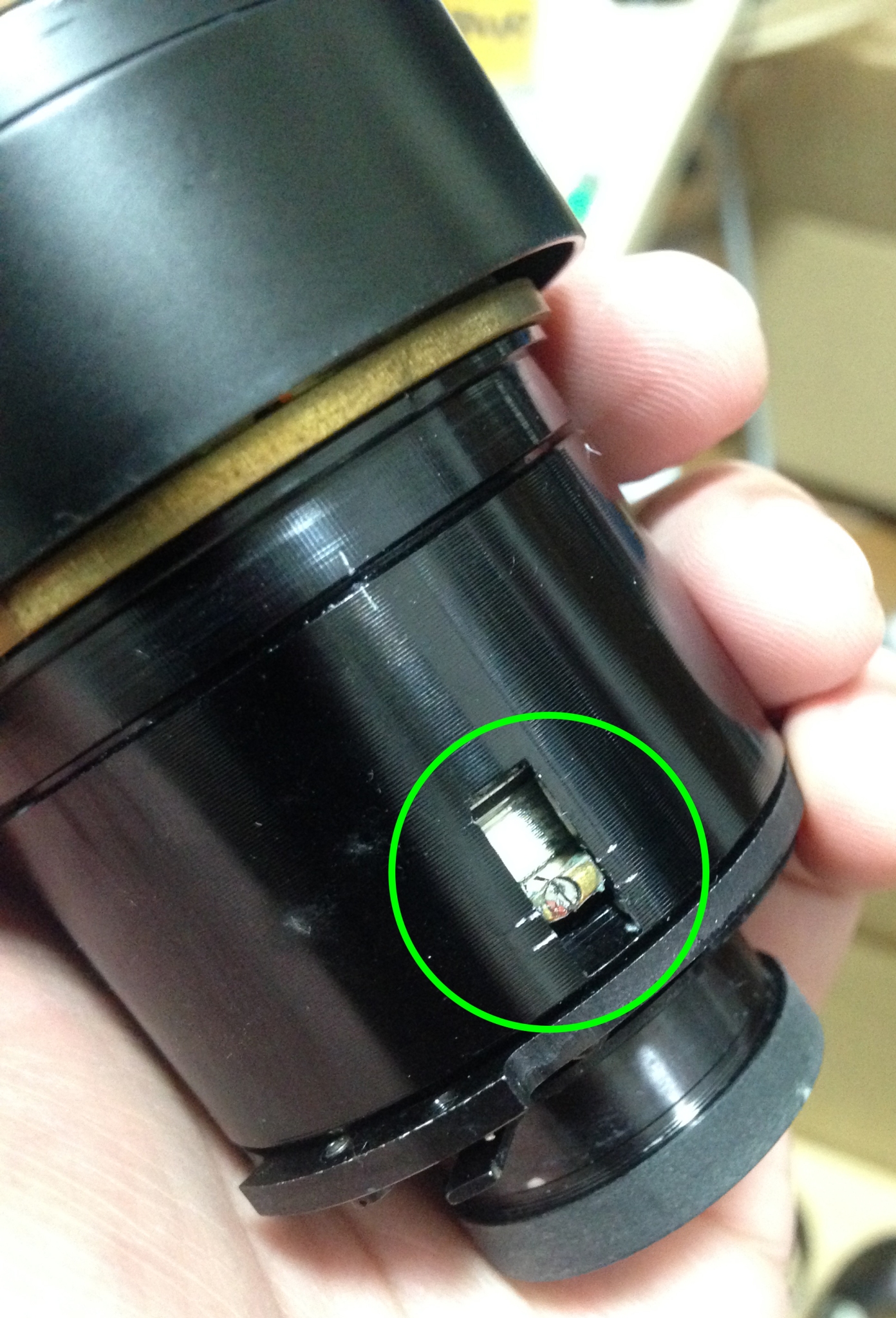
For lenses with CRC floating elements, be sure that you mark and measure the tolerances carefully because this is a precise alignment. Document everything that you can before you disassemble anything like this.
Finally, make sure that your mark is placed somewhere that will not be seen when the lens is reassembled.
Cleaning:
Once you get them separated, it is time to clean the disgusting stuff from the helicoids and replace them with fresh grease! Yeah!
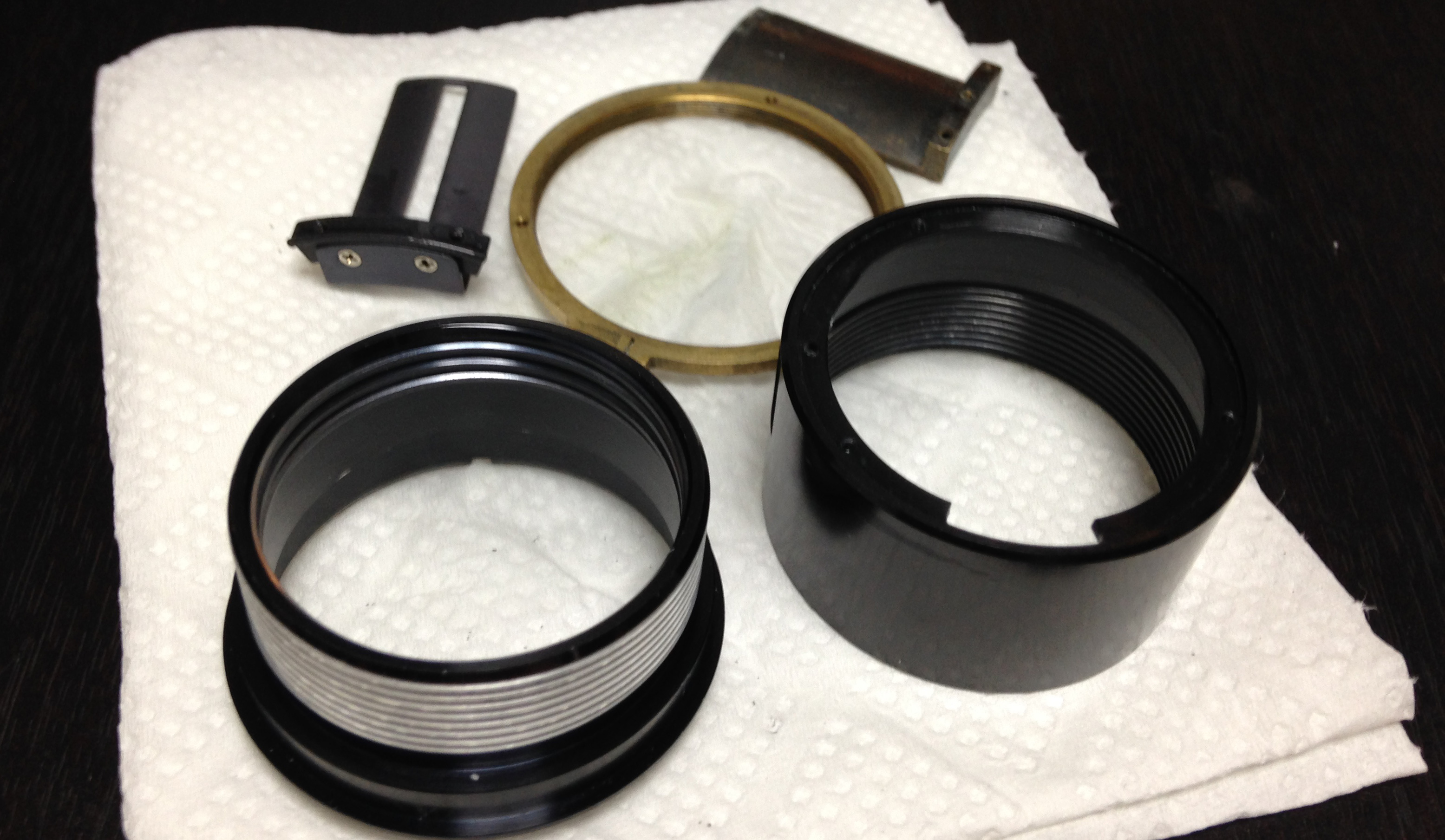
Prepare your helicoid so that they are safe from scratches. Any damage to the threads will be felt each time you turn your focusing ring and will even prevent you from mating these together again.
Start by wiping as much of the old grease from each part using Kleenex. You may use up to (4) sheets on a single helicoid so be sure that you have enough of it. This is the dry part of it. Next, apply some lighter fluid on the Kleenex and wipe the helicoids until most of the gunk is gone.
Now, go to your garage (I do this on the toilet) and scrub each helicoid with a toothbrush and some lighter fluid. You will make a mess on the floor so be prepared. Make sure that you do not leave any grime on the helicoids. For really stubborn and caked grime, a Dremel with a wire brush should do the trick. Just make sure that you use the soft type so you will not damage the threads of the helicoids. Never use this brush to clean anything else!
After all of the helicoids are cleaned mechanically with a brush, dunk these in a container with alcohol and leave it there for a couple of hours. This will remove any leftover dirt and it will soften the adhesive marks and other stuff so that you can simply wipe them off with a tissue later on. This is generally harmless to the helicoids and any of the metal parts of your lens but I got a case where the alcohol actually ruined the enamel of my lens, weird.
Wipe the helicoids dry with clean tissue until you do not see any dirt on the tissue after you wipe it. You do not want any of the old dirt to mix with the fresh grease! Use a bulb blower to blow away any fibres from the helicoids left by the Kleenex. Use a clean dry toothbrush and scrub the helicoids for the last time to make sure none of the grime is left on them.
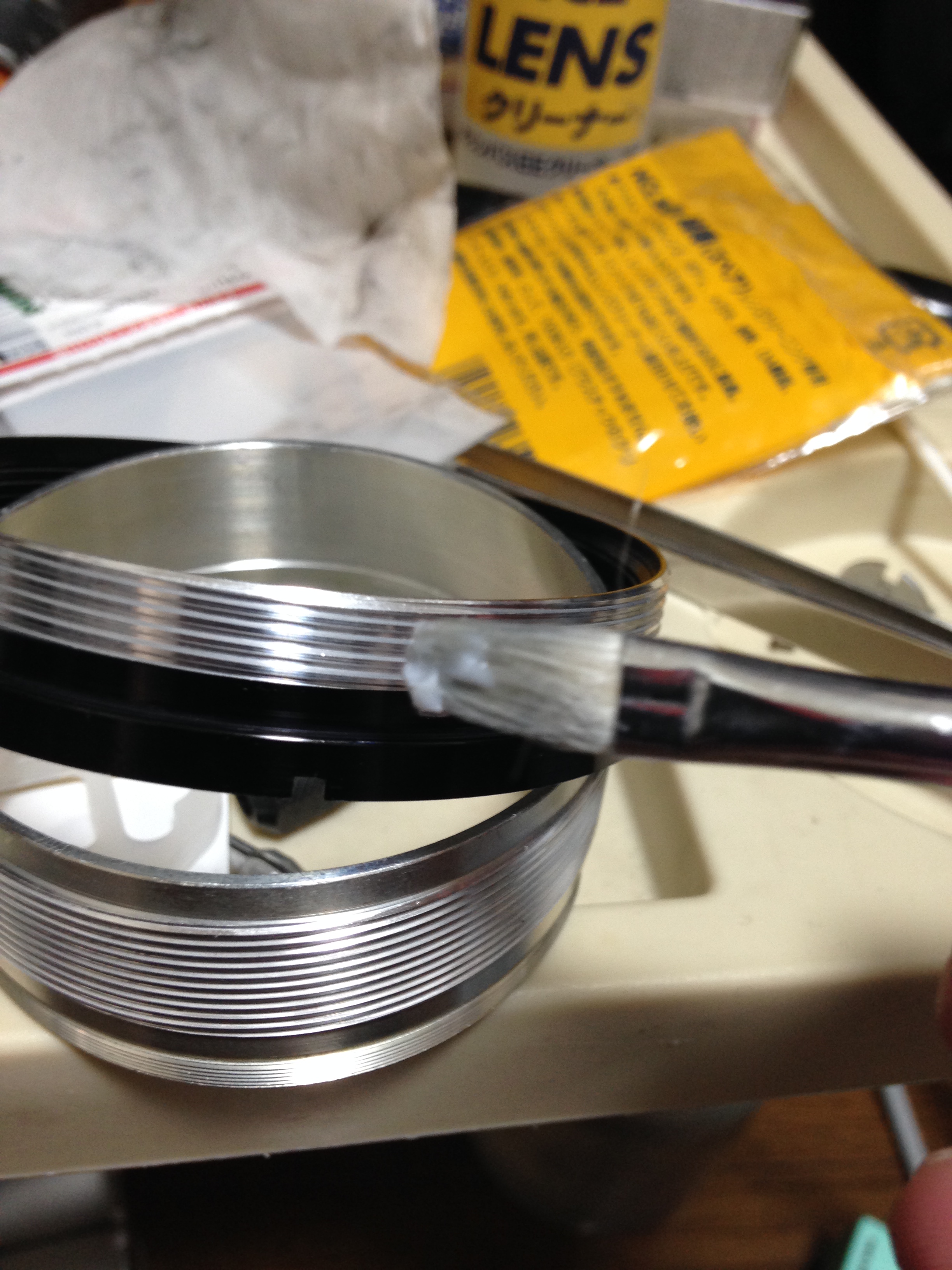
Make sure that your helicoids are dry and clean before you apply fresh grease. Mix the new grease first with a toothpick and then apply it with a flat brush. Do not apply too much of it or you will end up with an oily lens, too little and your focusing will not be damped.
Reassembly:
Simply align the helicoids to the marks that you have made when they separate and turn to the direction of the thread. Be careful and go gently on this step because if you use too much force you will wear the teeth down and mating the helicoids will be a tough job for you since it does’t “bite” anymore.
Rebuild your lens until you have reached the same point as you started. You should check the tolerances very well by referencing from the notes and markings that you made.
Conclusion:
I hope that you have enjoyed and learned from this blog post and if you have any ideas or experience that you would like to share, please leave me a comment and I will add it to this post. See you next time and thank you very much for following my blog, Ric.
Help Support this Blog:
Maintaining this blog requires money to operate. If you think that this site has helped you or you want to show your support by helping with the site’s upkeep, you can make a small donation to my paypal.com (richardHaw888@gmail.com). Money is not my prime motivation for this blog and I believe that I have enough to run this but you can help me make this site (and the companion facebook page) grow.
Buy me a roll of film or a burger?
Thank you very much for your continued support!
$2.00
Helping support this site will ensure that this will be kept going as long as I have the time and energy for this. I would appreciate it if you just leave out your name or details like your country’s name or other information so that the donations will totally be anonymous. This is a labor of love and I intend to keep it that way for as long as I can. Ric.

May 07, 2017 @ 17:20:02
I have a beautiful Rokkor 40 f2. (M mount) while in the process of cleaning managed to get the helicoid out and am struggling to put it back. Could this be fixed?
May 08, 2017 @ 02:00:58
Hello, Prakash.
Please try the trick that I am showing in the video and guess it for yourself. It is going to take you a lot of time but that is what you get for not taking any notes. Good luck, Ric.
May 08, 2020 @ 17:32:24
Hello Richard.
Thank God I found your blog!
My problem is that I’ve got a stripped-down lens with unbranded helicoid settings. The lens “broke” during the inspection and I don’t know how to hit the right settings. This is a copy of the Vivitar 200mm f/3.5 T-mount with 18 leaf aperture, Dollonds-S to be exact. Could you suggest anything? My amateur enthusiastic knowledge has just fallen on a thousand infinity tests.
Kind regards,
Tom
Nov 18, 2023 @ 14:27:05
So…I found this after I was having problems with re aligning everything in the Helicoid assembly, I did some googling and realised I should have made a lot more marks. Is there a way I can get it back to how it was before I disassembled it? The lens I have is a second generation Super Takumar 50mm f1.4. Thanks.